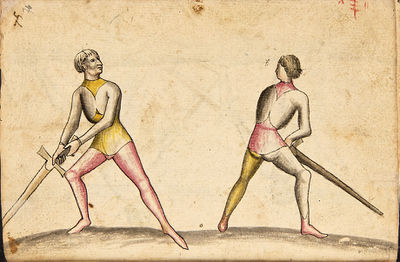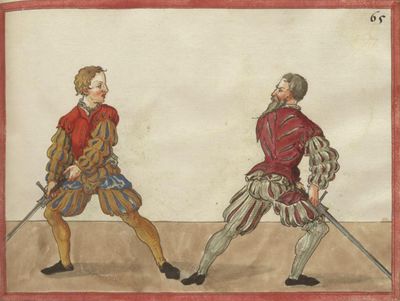|
|
You are not currently logged in. Are you accessing the unsecure (http) portal? Click here to switch to the secure portal. |
Difference between revisions of "Wechselhauw"
James Reilly (talk | contribs) |
James Reilly (talk | contribs) |
||
| Line 2: | Line 2: | ||
== Primary Sources == | == Primary Sources == | ||
| + | |||
| + | {{hidden begin | ||
| + | | title = <span style="font-size:1.17em;">[[Paulus Hector Mair]]'s Treatise (1542)</span> | ||
| + | | titlestyle= background:#f2f2f2; border:1px solid #aaaaaa; padding:10px 10px 12px 10px; text-align:center; vertical-align:middle; width:60%; | ||
| + | | bodystyle = display:block; width:224em; | ||
| + | }} | ||
| + | {{#lst: Paulus Hector Mair | Credits2 }} | ||
| + | {{#lst: Paulus Hector Mair | Wechselhauw }} | ||
| + | |||
| + | |} | ||
| + | {{hidden end}} | ||
{{hidden begin | {{hidden begin | ||
Revision as of 04:31, 21 April 2016
The Wechselhauw (Change cut) is a term used in the late period of the Liechtenauer tradition describing a cut that attacks one opening following an attack to different opening. Mair seems to refer to a cut that brings the sword diagonally from one quarter to another. Mair also uses the term for the final position of the cut. Meyer is less clear. The essence of the technique is that it follows either a faint or full cut. Either way, the second attack should target a different opening than the first.
Primary Sources
Source Illustrations |
Incomplete Translation |
Dresden Ⅰ Version (1540s) |
Vienna Ⅰ Version [German] (1550s) |
Munich Ⅰ Version (1540s) Transcribed by Per MAgnus Haaland |
Vienna Ⅰ Version [Latin] (1550s) |
Draftbook Version (1540s)
| |
|---|---|---|---|---|---|---|---|
|
[65] The Wechselhaw from Both Sides When you come to the closing with the opponent and strike in the Wechsel ("Changer"), set your left foot forward and strike from below at his face such that the short edge stands high. Then step outward with your right foot and strike with the long edge to the right side of his head. If you then likewise stand opposite him in the Wechselhaw ("Changing Strike") and have your left foot set forward[1] and he strikes in high towards you, then follow outward with your right foot and displace this with the long edge. Then immediately strike from below to his right side with crossed arms and with the long edge. If he displaces this, then take your strike again from below and Wechsel high double to his head. Should you perceive the Wechsel, displace it with your short edge and strike to his head with your long edge. If he displaces this, strike to the right side of his head with the Zwirch with crossed arms. |
[054r] Der wechselhaw vonn baiden seiten. Item wann du mit dem zufechten zu dem Man kompst. vnnd dich Inn den wechsel hawest. so setz deinnen Linncken fuosz vor. vnnd streich vonn vnnden auf. zu seinnem gesicht. das die kurtz schneid oben stee. trit mit deinnem Rechten fuosz hinnach. vnnd haw Im mit lannger schneid oben zu dem kopff seinner rechten seiten. stastu dann auch gogen Im Inn dem wechselhaw. vnnd hast deinnen Linncken fuosz furgesetzt. vnnd er dir oben einhawt. so volg mit deinnem rechten fuosz hinnach. vnnd versetz Im das mit lannger schneid. Indes haw Im vnnden zu seinner rechten seiten mit Creitzweisen hennden mit deinner Lanngen Schneid. versetzt er dir das. so nimb deinnen haw vnnden wider. vnnd wechsel Im oben zwifach zu dem kopff. wirstu des wechsels gewar. so versetz Im den mit deinner kurtzen schneid. vnnd mit deinner langen haw Im zu seinnem haupt. versetzt er dir das. so haw Im die zwirch mit gecreitzgiten Armen zu seinner Rechten seiten seinnes kopffs. |
[033r] Der Wechselhaw von baiden seitten. Item wann du mit dem zufechten zu dem mann kombst, und dich in den wechsel hawest, so setz deinen linggen fuß vor, unnd streich von unden auf zu seinem gesicht, das die kurtz schneid oben stee, trit mit deinem rechten fuß hinnach, und haw Im mit langer schneid oben zu dem kopff seiner rechte seitten. Steest du dann auch gegen Im in dem wechselhaw, und hast deinen linggen fuß fürgesetzt, und er dir oben einhawt, so volg mit deinem rechten fuß hinnach, und versetz im das mit langer schneid. Versetzt er dir das, so nimb deinen haw unden wider und wechsel Im oben zwifach zu dem kopff. Wirst du des wechsels gewar, so versetz Im den mit deiner kurtzen schneid, unnd mit deiner langen haw Im zu seinem haubt. Versetzt er dir das, so haw Im die Zwirch mitt gekreutzgiten armen zu seiner rechten seitten seines kopffs. |
[050r] Ictus qui a mutando dicitur mutatorius, ab utroque latere. Quum in adversarii conspectum prope fueris progressus more gladiatorio ensem usurpando, atque ictum praedictum ferias, praeposito sinistro, inferne vibrato, ensem sursum contra faciem adversarii, brevi acie locum superiorem habente, dextro insequutus, versus capitis eius partem dextram acie longa praemissa ferias superne consistente, vero te contra adversarium in ictu mutatorio praenominato praeposito etiam sinistro, atque is e supernis referiat, dextro mox insequere, et excipito eum acie longa porrecta, interimque inferne manibus transversis versus latus adversarii dextrum ferito acie longa ensis tui praemissa. Verum adversario id avertente, tum rursus ictum arripito inferne, et dupliciter mutato versum eius caput. Sin autem id ab adversario factum fuerit, ac observaris, eum excipito acie brevi atque longa caput eius quassato, sed si exceperit hostis, tum transversarium usurpando brachiis cancellatis dextram adversarii partem capitis appetito. |
[033r] |
|
Figures |
1570 Edition
| |
|---|---|---|
Change Strike The Change Strike is nothing other than changing from one side to the other, from above to below and back again, before striking your opponent, thus make it so. |
[Ⅰ.14v.3] Wechselhauw. DEr Wechselhauw ist nichts anders, dann vor dem Manne mit den häuwen von einer seiten zur andern, von Oben zum Undern und hinwider abwechseln, ihn damit irre zumachen. |
- ↑ Cite error: Invalid
<ref>tag; no text was provided for refs namedillustration


